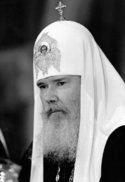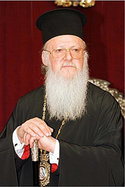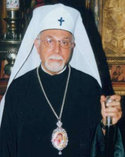Biserica Ortodoxă a Estoniei (Patriarhia Ecumenică): Diferență între versiuni
(propunere de traducere de pe orthodoxwiki.org) |
|||
| Linia 1: | Linia 1: | ||
{{Traducere EN}} | {{Traducere EN}} | ||
| − | [[Image:Tallinn.jpg|right|350px|thumb| | + | [[Image:Tallinn.jpg|right|350px|thumb|Biserici în Tallinn, capitalaEstoniei]] |
| − | {{ | + | {{numele bisericii| |
| − | + | nume=Biserica Apostolică Ortodoxă Estoniană| | |
| − | + | fondator=—| | |
| − | + | independenţa=1917| | |
| − | + | recunoaşterea=1923, 1996 de către [[Patriarhia Ecumenică|Constantinopol]]| | |
| − | + | patriarhul=[[Stephanos (Charalambides) din Tallinn|Mitropolitul Stephanos]]| | |
| − | + | sediul central=Tallinn, Estonia| | |
| − | + | teritoriu=Republic Estonia| | |
| − | + | posesiuni=—| | |
| − | + | limba=Estoniană| | |
| − | + | muzică=[[stilul bizantin|bizantin]] şi [[tradiţional Estonian|Estonian]]| | |
| − | calendar=[[ | + | calendar=[[calendar gregorian|gregorian]]| |
| − | + | populatiţia=20,000[http://www.cnewa.org/ecc-bodypg.aspx?eccpageID=33]| | |
| − | website=[http://www.eoc.ee/ | + | website=[http://www.eoc.ee/ Biserica Estoniei] |
}} | }} | ||
| − | + | '''Biserica din Estonia''' sau '''Biserica Apostolică Ortodoxă Estoniană ''' ('''Eesti Apostlik-Õigeusu Kirik''') este o biserică ortodoxă [[autonomie|autonomă]] al cărei [[patriarh]] este confirmat de către [[Patriarhia Ecumenică]]. Numele ei oficial în limba engleză este Biserica Ortodoxă Estoniană'''. | |
| − | + | Patriarhul actual este Eminenţa Sa [[Stephanos (Charalambides) din Tallinn|Stephanos]], [[Mitropolit]] de Tallinn şi toată Estonia (ales în 1999). | |
| − | + | Această biserică autonomă nu trebuie confundată cu [[Biserica Estoniană (Patriarhia Moscovei)|biserica cu acelaşi nume]] care este un [[exarhat]] al [[Patriarhia Moscovei|Patriarhiei Moscovei]]. | |
| − | == | + | ==Istorie== |
| − | + | Misionari ortodocşi au activat printre estonieni în regiunile sud-estice, aproape de Pskov, din secolul X până în secolul XII. Prima menţiune a unei comunităţi ortodoxe în Estonia datează din 1030 în Tartu. În jurul anului 600 AD în partea estică a dealului Toome (Toomemägi), estonienii au ridicat o fortăreaţă numită Tarbatu. În 1030, prinţul kievean Jaroslav cel Înţelept, a demolat Tarbatu şi şi-a construit propriul fort în acest loc ca şi o catedrală închinată Sfântului [[Gheorghe Purtătorul de Biruinţă]] . Creştinii ortodocşi au fost ulterior expulzaţi din oraş de germani în 1472, care le-au omorât [[preot|preotul]] Isidor împreună cu un anumit număr de credincioşi ortodocşi (grupul este comemorat în [[8 ianuarie]]). | |
| + | Se ştiu puţine despre istoria bisericii în timpul secolelor XVII şi XVIII, când mulţi [[credincioşi vechi|credincioşi vechi]] au venit din Rusia pentru a scăpa de reformele liturgice ale Patriarhului [[Nikon de Moscova]]. | ||
| − | + | În secolele XVIII şi XIX, Estonia a făcut parte din Imperiul Ţarist Rus, fiind cucerită de Ţarul [[Petru cel Mare]]. Un mare număr de estonieni, în special ţărani, s-au convertit la ortodoxie în speranţa obţinerii de pământ. S-au construi numeroase biserici ortodoxe. În 1850 a fost înfiinţată Eparhia de Riga (în Lituania) de către [[Biserica Rusiei]] şi mulţi credincioşi estonieni au fost incluşi în aceasta. Spre sfârşitul secolului XIX, s-a produs un val de rusificare, acceptat de ierarhia rusă dar nu şi de clerul estonian local. Catedrala Sfântul[[Alexander Nevsky]] din Tallinn şi Mănăstirea Adormirii Pühtitsa [[Stavropigial|Stavropegic]] (Kuremäe) din estul Estoniei au fost construite în această perioadă. | |
| − | + | În 1917 a fost hirotonit primul estonian, Platon (Paul Kulbusch), ca Episcop de Riga şi Vicar de Tallin. Doi ani mai târziu, bolşevicii l-au omorât pe Platon şi pe [[diacon|diaconul]] său din motive politice. 81 de ani mai târziu, în anul 2000, Episcopul Platon a fost [[proclamat sfânt]] de către Patriarhia Ecumenică şi de Rusia, fiind comemorat în [[14 ianuarie]]. | |
| − | + | După proclamarea Republicii Estonia în 1918, Patriarhul Bisericii Ortoxe Ruse, Sfântul [[Tihon din Moscow|Tihon]],, în 1920 a recunoscut Biserica Ortodoxă a Estoniei (OCE) ca fiind independentă. Arhiepiscopul Aleksander Paulus a fost ales şi hirotonit ca şef al bisericii estoniene. În 1923 Arhiepiscopul Aleksander s-a îndreptat către Patriarhia Ecumenică pentru a primi recunoaşterea canonică. În acelaşi an, OCE a fost subordonată canonic către Patriarhul Constantinopolului şi a câştigat o [[autonomie]]extinsă. | |
| − | |||
| − | |||
Before 1941, one fifth of the total Estonian population (who had been mostly Lutheran since the 16th century occupation of Estonia by Sweden) were Orthodox Christians under the Patriarchy of Constantinople. There were 158 parishes in Estonia and 183 clerics in the Estonian church. There was also a Chair of Orthodoxy in the Faculty of Theology at the University of Tartu. There was a [[monastery]] in Petseri, two convents in Narva and Kuremäe, a priory in Tallinn and a [[seminary]] in Petseri. The ancient monastery in Petseri (Pechory, which used to belong to the Estonian Republic, now belongs to Russia) was preserved from the mass church destructions that occurred in Soviet Russia. | Before 1941, one fifth of the total Estonian population (who had been mostly Lutheran since the 16th century occupation of Estonia by Sweden) were Orthodox Christians under the Patriarchy of Constantinople. There were 158 parishes in Estonia and 183 clerics in the Estonian church. There was also a Chair of Orthodoxy in the Faculty of Theology at the University of Tartu. There was a [[monastery]] in Petseri, two convents in Narva and Kuremäe, a priory in Tallinn and a [[seminary]] in Petseri. The ancient monastery in Petseri (Pechory, which used to belong to the Estonian Republic, now belongs to Russia) was preserved from the mass church destructions that occurred in Soviet Russia. | ||
Versiunea de la data 19 noiembrie 2007 12:16
| Acest articol (sau părți din el) este propus spre traducere din limba engleză!
Dacă doriți să vă asumați acestă traducere (parțial sau integral), anunțați acest lucru pe pagina de discuții a articolului. |
Format:Numele bisericii Biserica din Estonia sau Biserica Apostolică Ortodoxă Estoniană (Eesti Apostlik-Õigeusu Kirik) este o biserică ortodoxă autonomă al cărei patriarh este confirmat de către Patriarhia Ecumenică. Numele ei oficial în limba engleză este Biserica Ortodoxă Estoniană.
Patriarhul actual este Eminenţa Sa Stephanos, Mitropolit de Tallinn şi toată Estonia (ales în 1999).
Această biserică autonomă nu trebuie confundată cu biserica cu acelaşi nume care este un exarhat al Patriarhiei Moscovei.
Istorie
Misionari ortodocşi au activat printre estonieni în regiunile sud-estice, aproape de Pskov, din secolul X până în secolul XII. Prima menţiune a unei comunităţi ortodoxe în Estonia datează din 1030 în Tartu. În jurul anului 600 AD în partea estică a dealului Toome (Toomemägi), estonienii au ridicat o fortăreaţă numită Tarbatu. În 1030, prinţul kievean Jaroslav cel Înţelept, a demolat Tarbatu şi şi-a construit propriul fort în acest loc ca şi o catedrală închinată Sfântului Gheorghe Purtătorul de Biruinţă . Creştinii ortodocşi au fost ulterior expulzaţi din oraş de germani în 1472, care le-au omorât preotul Isidor împreună cu un anumit număr de credincioşi ortodocşi (grupul este comemorat în 8 ianuarie). Se ştiu puţine despre istoria bisericii în timpul secolelor XVII şi XVIII, când mulţi credincioşi vechi au venit din Rusia pentru a scăpa de reformele liturgice ale Patriarhului Nikon de Moscova.
În secolele XVIII şi XIX, Estonia a făcut parte din Imperiul Ţarist Rus, fiind cucerită de Ţarul Petru cel Mare. Un mare număr de estonieni, în special ţărani, s-au convertit la ortodoxie în speranţa obţinerii de pământ. S-au construi numeroase biserici ortodoxe. În 1850 a fost înfiinţată Eparhia de Riga (în Lituania) de către Biserica Rusiei şi mulţi credincioşi estonieni au fost incluşi în aceasta. Spre sfârşitul secolului XIX, s-a produs un val de rusificare, acceptat de ierarhia rusă dar nu şi de clerul estonian local. Catedrala SfântulAlexander Nevsky din Tallinn şi Mănăstirea Adormirii Pühtitsa Stavropegic (Kuremäe) din estul Estoniei au fost construite în această perioadă.
În 1917 a fost hirotonit primul estonian, Platon (Paul Kulbusch), ca Episcop de Riga şi Vicar de Tallin. Doi ani mai târziu, bolşevicii l-au omorât pe Platon şi pe diaconul său din motive politice. 81 de ani mai târziu, în anul 2000, Episcopul Platon a fost proclamat sfânt de către Patriarhia Ecumenică şi de Rusia, fiind comemorat în 14 ianuarie.
După proclamarea Republicii Estonia în 1918, Patriarhul Bisericii Ortoxe Ruse, Sfântul Tihon,, în 1920 a recunoscut Biserica Ortodoxă a Estoniei (OCE) ca fiind independentă. Arhiepiscopul Aleksander Paulus a fost ales şi hirotonit ca şef al bisericii estoniene. În 1923 Arhiepiscopul Aleksander s-a îndreptat către Patriarhia Ecumenică pentru a primi recunoaşterea canonică. În acelaşi an, OCE a fost subordonată canonic către Patriarhul Constantinopolului şi a câştigat o autonomieextinsă.
Before 1941, one fifth of the total Estonian population (who had been mostly Lutheran since the 16th century occupation of Estonia by Sweden) were Orthodox Christians under the Patriarchy of Constantinople. There were 158 parishes in Estonia and 183 clerics in the Estonian church. There was also a Chair of Orthodoxy in the Faculty of Theology at the University of Tartu. There was a monastery in Petseri, two convents in Narva and Kuremäe, a priory in Tallinn and a seminary in Petseri. The ancient monastery in Petseri (Pechory, which used to belong to the Estonian Republic, now belongs to Russia) was preserved from the mass church destructions that occurred in Soviet Russia.
In 1940, Estonia was occupied by the Soviet Union, whose government undertook a general programme of the dissolution of all ecclesiastical independence within its territory. From 1942 to 1944, however, autonomy under Constantinople was temporarily revived. In 1945, a representative of the Moscow Patriarchate dismissed the members of the OCE synod who had remained in Estonia and established a new organisation, the Diocesan Council. Orthodox believers in occupied Estonia were thus subordinated to being a diocese within the Russian Orthodox Church.
Just before the second Soviet occupation in 1944 and the dissolution of the Estonian synod, the primate of the church, Metropolitan Aleksander, went into exile along with 21 clergymen and about 8,000 Orthodox believers. The Orthodox Church of Estonia in Exile with its synod in Sweden continued its activity according to the canonical statutes, until the restoration of Estonian independence in 1991. Before he died in 1953, Metr. Aleksandr established his community as an exarchate under Constantinople. Most of the other bishops and clergy who remained behind were deported to Siberia. In 1958, a new synod was established in exile, and the church organized from Sweden.

Following the breakup of the Soviet Union, divisions within the Orthodox community in Estonia arose between those who wished to remain under Russian authority and those who wished to return to the jurisdiction of the Ecumenical Patriarchate, with the dispute often taking place along ethnic lines, many Russians having immigrated to Estonia during the Soviet occupation. Lengthy negotiations between the two patriarchates failed to produce any agreement.
In 1993, the synod of the Orthodox Church of Estonia in Exile was re-registered as the legal successor of the autonomous Orthodox Church of Estonia, and on February 20, 1996, Ecumenical Patriarch Bartholomew I renewed the tomos granted to the OCE in 1923, restoring its canonical subordination to the Ecumenical Patriarchate. This action brought immediate protest from Patriarch Alexei II of the Moscow Patriarchate, which regarded the Estonian church as being part of its territory, and the Patriarch of Moscow temporarily removed the name of the Ecumenical Patriarch from the diptychs.
An agreement was reached in which local congregations could choose which jurisdiction to follow. The Orthodox community in Estonia, which accounts for about 14% of the total population, remains divided, with the majority of faithful (mostly ethnic Russians) remaining under Moscow. As of a government report of November 2003, about 20,000 believers (mostly ethnic Estonians) in 60 parishes are part of the autonomous church, with 150,000 faithful in 31 parishes, along with the monastic community of Pukhitsa, paying allegiance to Moscow.
In 1999, the church gained a resident hierarch (it had been under the Archbishop of Finland as locum tenens), Metropolitan Stephanos (Charalambides), who had formerly been an auxiliary bishop under the Ecumenical Patriarchate's Metropolitan of France.
Sources
- Blackwell Dictionary of Eastern Christianity, pp. 183-4
- The Estonian Apostolic Orthodox Church by Ronald Roberson, a Roman Catholic priest and scholar


